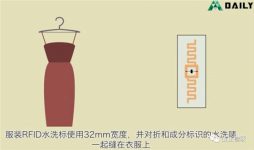
Application of RFID technology in clothing industry
[ad_1]
Daili IoT’s RFID technology is currently being applied in the garment industry’s production process, warehousing management, storefront retail, and commodity inventory.
1. Label introduction and binding
First, use the UHF card issuing machine to write some important attributes of a single piece of clothing such as name, grade, article number, model, fabric, lining, washing method, execution standard, product number, inspector number, etc. into the corresponding electronic label. And attach the electronic tag to the clothing. Bind the original barcode and RFID code on the clothes through the binding machine. Each piece of clothing is given a unique electronic tag identification that is difficult to forge, which can effectively avoid counterfeiting and well solve the problem of clothing anti-counterfeiting.



2. RFID warehouse management
Read the label remotely when passing the entrance and exit. First, the yellow light will be on and wait for inspection; the product is correct, the green light is on, and it is passable; the number of products is abnormal, and the red light is on, and no pass is allowed.

Three. Store receipt
After receiving the goods in the store, you only need to use the handheld to scan the goods to complete the goods verification.

4. Selling clothes
A desktop card reader is used at the checkout counter, and the sales status of the clothes is automatically changed after the customer purchases the clothes.

5. Commodity theft prevention
When the unpaid products leave the store, an RFID reader is installed on the column at the door to automatically sense the alarm, and the guard will receive the alarm, location and name of the product as soon as possible.


6. Fitting statistics
Install RFID readers in the fitting room to count the fitting rate of each garment and recommend other suitable styles for customers

Seven. Store inventory
Just use the handheld to scan the inventory.
System design function
This solution uses RFID technology, database technology and computer network technology, and integrates:
(1) Garment production line management;
(2) Clothing digital warehousing and rapid response logistics management;
(3) Clothing order fair management;
(4) Clothing store management;
(5) Functional modules such as clothing anti-counterfeiting and anti-smuggling management.
In the garment production line, the production schedule will be effectively balanced and regulated, and workers’ wages will be settled quickly and real-time information will be collected.
In the digital warehousing and rapid response logistics links, fast inventory, reduce human errors and save manpower and time.
In the clothing order fair, customers can place orders conveniently, provide timely feedback on hot and slow-selling products, and control the entry of the venue and intelligent anti-theft to ensure the safety of the order fair.
In the clothing store management link, new sales models such as automatic settlement, smart clothes matching, and smart advertising promotion stimulate customers’ desire to consume and increase store sales.
In the anti-counterfeiting and anti-smuggling management module, it can effectively identify the authenticity of clothing, query clothing sales areas, and combat counterfeit and shoddy and cross-regional sales that affect market order and endanger the interests of businesses and consumers.
[ad_2]




